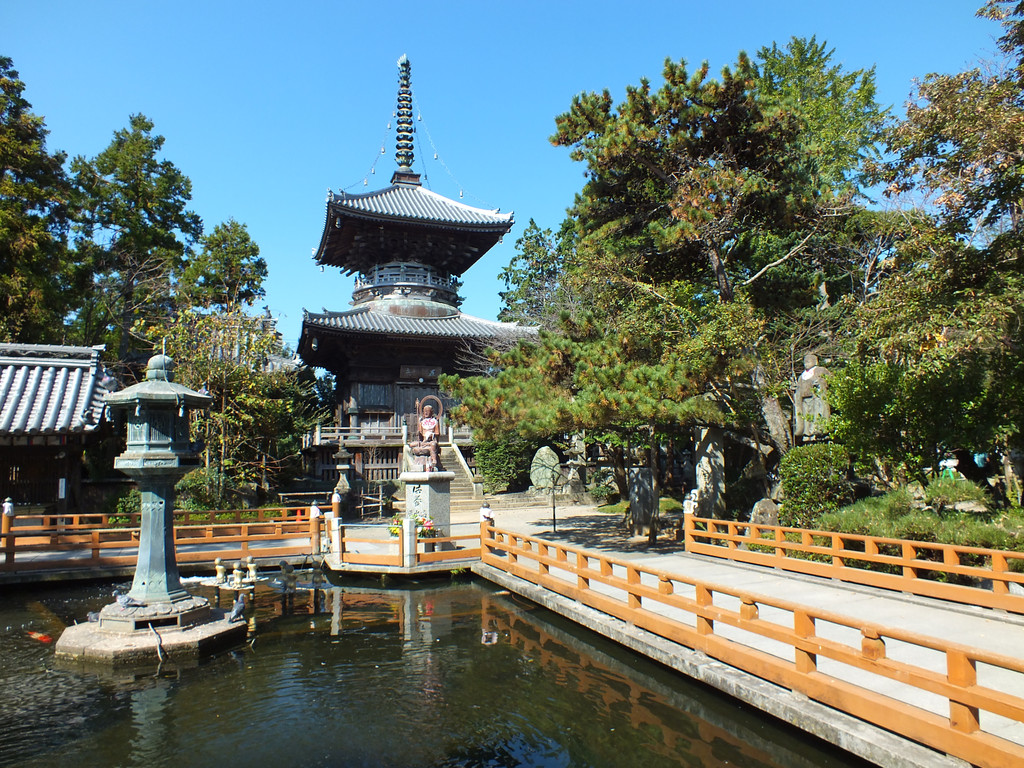🌸 Are you feeling adventurous and seeking a spiritual journey through the breathtaking landscapes of Japan’s scenic Temples and Shrines on Shikoku Island? Then, buckle up and join me on a once-in-a-lifetime experience to explore the 88 Temple Pilgrimage, a traditional Buddhist route thousands of pilgrims have traveled for centuries.
🌟 Shikoku Island is a treasure trove of natural beauty, rich history, and cultural heritage. It is the smallest of Japan’s four main islands but packs a powerful punch with its serene mountains, pristine rivers, and stunning coastlines. But what sets Shikoku Island apart is its spiritual significance, as it is home to the famous 88 Temples and Shrines on Shikoku Pilgrimage.
History and Background of Shikoku’s 88 Temple Pilgrimage
🕉️ The 88 Temple Pilgrimage is a 1,200-kilometer route that takes pilgrims to 88 Buddhist temples and shrines across Shikoku Island. The pilgrimage route is believed to have been created by the famous Buddhist monk Kukai, also known as Kobo Daishi, in the 9th century. It is said that Kukai traveled to China to study Buddhism and, upon his return, created the 88 Temple Pilgrimage to spread the teachings of Buddhism throughout Japan.
88 in Buddhism
88 is significant in Buddhism and represents the number of earthly desires a person must overcome to achieve enlightenment. The pilgrimage is designed to help pilgrims overcome these desires and reach a state of spiritual enlightenment.
🙏 The pilgrimage route has been completed by millions of people over the centuries, both for spiritual and personal reasons. The journey is said to symbolize the path to enlightenment and spiritual rebirth. It is a physical and emotional challenge that takes pilgrims through some of Shikoku Island’s most beautiful and spiritually significant temples and shrines.
Some Temples and Shrines on Shikoku Temple Pilgrimage
🏯 Let’s explore some of the best temples and shrines along the route, including Ryozenji Temple, Gokurakuji Temple, Konsenji Temple, Dainichiji Temple, Jizoji Temple, Anrakuji Temple, Yakuriji Temple, Taisanji Temple, Ishiteji Temple, Enkouji Temple, Ryotanji Temple, Okuboji Temple, Kongochoji Temple, Negoroji Temple, and Shinshoji Temple. These temples are stunningly beautiful and rich in history and culture, making them a must-visit for any traveler seeking to explore Japan’s spiritual heritage.
🥾 The pilgrimage route is not for the faint of heart and requires physical endurance, mental fortitude, and proper planning. The journey can take up to two months, depending on the pilgrim’s pace and itinerary.
However, there are several lodgings and accommodations along the route, including pilgrim lodges called “shukubo,” where pilgrims can rest and rejuvenate before continuing their journey.
Let’s Try Some Local Cuisine
🍜 Along the way, pilgrims can indulge in the local cuisine, which includes traditional Japanese dishes made with fresh seafood and seasonal vegetables. Local festivals and events also occur throughout the year, providing a unique opportunity to experience the region’s cultural heritage.
🌿 As you trek through the pilgrimage route, you will be surrounded by the stunning natural beauty of Shikoku Island. Walking and hiking through the region’s mountains, forests, and rivers is a great way to connect with nature and deepen your spiritual journey.
🎉 So, are you ready to take on this spiritual and cultural adventure through Shikoku Island’s 88 Temple Pilgrimage? Join me, and let’s embark on a journey that will leave a lasting impression on your mind, body, and soul.
Tips: Before starting the pilgrimage, learn about the history and significance of each temple to fully appreciate the spiritual journey. You can hire a guide or join a group for a more immersive experience.
The Best Temples and Shrines on Shikoku’s 88 Temple Pilgrimage
Ryozenji Temple
Ryozenji Temple is the starting point of the pilgrimage and is located in Naruto City, Tokushima Prefecture. The temple has a unique Zen garden and historical statues worth exploring.
Tips: Take your time to explore the temple’s garden and statues. You can also participate in meditation sessions to fully immerse yourself in the spiritual journey.

Konsenji Temple
Konsenji Temple is located in the city of Kamiita, Tokushima Prefecture. The temple is known for its beautiful garden and stunning views of the Seto Inland Sea. The temple also has a unique bell that pilgrims ring to announce their arrival.
Tips: Take in the stunning views of the Seto Inland Sea while exploring the temple’s garden. Make sure to ring the bell to announce your arrival.
Ichinomiyaji Temple
Ichinomiyaji Temple is located in the city of Awa, Tokushima Prefecture. The temple has a unique pagoda and stunning mountain views that are worth the climb. The temple also has a large bell rung by pilgrims to ward off evil spirits.
Tips: Take the time to climb the mountain and enjoy the stunning views. Ring the temple’s bell to ward off evil spirits and continue your journey with a peaceful mind.
Ishiteji Temple
Ishiteji Temple is located in the city of Matsuyama, Ehime Prefecture. The temple has a serene garden and impressive architecture that is worth exploring. The temple also has a large pagoda considered one of Japan’s tallest.
Tips: Take the time to explore the serene garden and appreciate the impressive architecture. You can also try the temple’s famous “ojuzu” beads, believed to have spiritual powers.
Yashimaji Temple
Yashimaji Temple is located in the city of Niihama, Ehime Prefecture. The temple has a peaceful atmosphere and beautiful cherry blossom trees, a must-see in spring. The temple also has a long history dating back to the 8th century, when it was founded by the famous monk Gyoki. It is said that the temple was once a training ground for warrior monks, who would use the surrounding mountains for martial arts training.
The temple grounds are beautifully landscaped with a pond, waterfall, and lush greenery. Visitors can take a stroll around the grounds and enjoy the area’s natural beauty.
The temple’s main hall is decorated with intricate carvings and paintings, and visitors can observe monks going about their daily routines and chanting prayers.
One of the highlights of Yashimaji Temple is the statue of Fudo Myoo, one of the Five Wisdom Kings in Buddhism. This imposing statue is over 10 meters tall and is said to have been carved by Gyoki.
Visitors can offer incense and prayers to Fudo Myoo and receive blessings for good luck and prosperity.
Tip: Be sure to visit Yashimaji Temple in the spring to see the beautiful cherry blossoms in bloom. The temple is also famous for its autumn foliage, which is equally stunning.
Tips for Pilgrims
- A. Research the temples you want to visit to ensure you make the most of your journey.
- B. Wear comfortable walking shoes and bring plenty of water and snacks for the long walks between the temples.
- C. Respect temple customs and dress appropriately by covering your shoulders and knees.
- D. Consider hiring a guide or joining a tour to gain deeper insight into the history and culture of the pilgrimage.
- E. Take your time and enjoy the journey, as the pilgrimage is not just about visiting the temples but also about the spiritual experience and personal growth it can bring.
Tips for Visiting the Temples and Shrines on Shikoku’s 88 Temple Pilgrimage
- Wear comfortable clothes and shoes: You’ll be doing a lot of walking, so it’s essential to wear comfortable clothing that won’t cause blisters or sore feet.
- Please bring plenty of water and snacks: It’s essential to stay hydrated and fueled during the pilgrimage, so make sure to bring plenty of water and snacks.
- There are vending machines and shops near most temples, but it’s always a good idea to get your supplies just in case.
- Respect the customs and traditions of the temples and shrines: The pilgrimage is a spiritual journey, so it’s important to respect the customs and traditions of each temple and shrine.
- Be mindful of any signs or instructions, and respect the monks and other visitors.
- Pace yourself and take breaks when needed: The pilgrimage can be physically and mentally demanding, so it’s important to pace yourself and take breaks when needed.
- Don’t feel like you need to rush through each temple and shrine – take your time and enjoy the journey.
- Learn about the history and significance of each temple and shrine: Each temple and shrine on the pilgrimage has a unique history and significance, so take the time to learn about each one.
- You’ll gain a deeper understanding of the spiritual and cultural significance of the pilgrimage.
- The 88 Temples and Shrines on Shikoku Island is a unique and rewarding experience that allows visitors to explore Japan’s spiritual and cultural aspects.
- Each temple and shrine on the pilgrimage has its unique history and significance, and visiting them all is a journey of self-discovery and personal growth.
Hopefully, This Guide Has Been Helpful
We hope this guide has given you some insights into some of the best temples and shrines on the pilgrimage. Remember to wear comfortable clothes and shoes, bring plenty of water and snacks, respect the customs and traditions of the temples and shrines, pace yourself, and take the time to learn about the history and significance of each temple and shrine.
Today, plan your visit to Shikoku’s 88 Temple Pilgrimage and experience Japan’s spiritual and cultural treasures.
- The Best Waterfalls in Kyushu: Enjoying the Island’s Natural Beauty
- The Best Parks in Tokyo That Will Amaze You
- “Top of the World: Mystical Summit Experience Of Mount Fuji”
- “Kumamoto Serenity: Unmasking The Secrets Of Its Natural Wonders”
- The Best Beach Resorts in Shikoku
- Shikoku Japan Guide: https://www.shikoku-japan-guide.com/
- Japan Guide – Shikoku Region: https://www.japan-guide.com/list/e1104.html
- The Official Shikoku Pilgrimage Website: https://www.shikokuhenrotrail.com/
- Shikoku 88 Temple Pilgrimage Guide: https://www.japanvisitor.com/japan-temples-shrines/shikoku-88-temple-pilgrimage
- Shikoku Pilgrimage: A 1,200-Year-Old Buddhist Tradition in Japan: https://theculturetrip.com/asia/japan/articles/shikoku-pilgrimage-a-1200-year-old-buddhist-tradition-in-japan/
- Sacred Sites of Japan’s Shikoku Island: https://www.nationalgeographic.com/travel/article/sacred-sites-japans-shikoku-island
- Japan Experience – The Shikoku Pilgrimage: https://www.japan-experience.com/to-know/cherry-blossom-shikoku-pilgrimage
- Shikoku Pilgrimage: Japan’s Spiritual Odyssey: https://edition.cnn.com/travel/article/shikoku-pilgrimage-japan/index.html
- The Best Temples on Japan’s Shikoku Island: https://theculturetrip.com/asia/japan/articles/the-best-temples-on-japans-shikoku-island/
- Japan National Tourism Organization – Shikoku Region: https://www.japan.travel/en/destinations/shikoku/

















